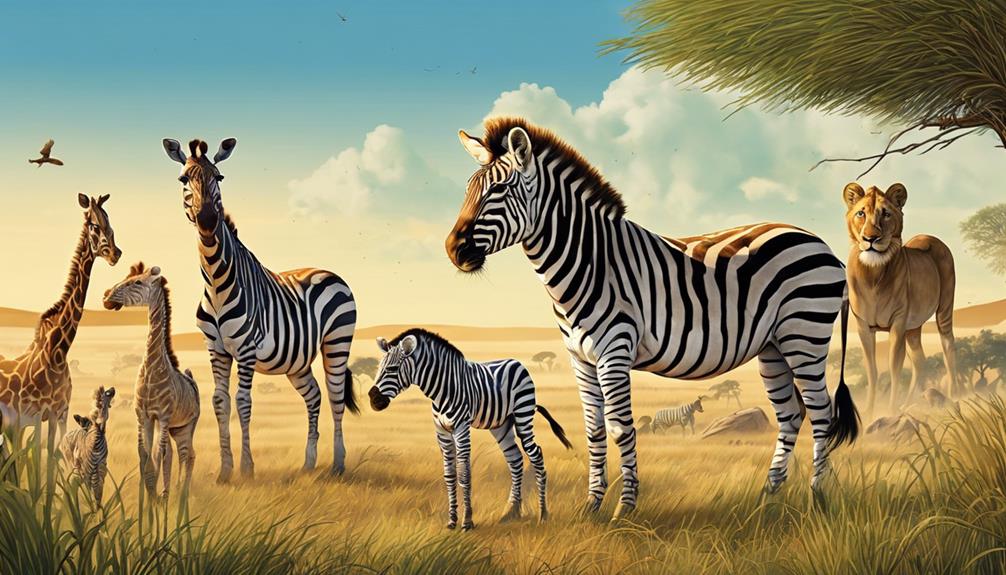Picture yourself standing on the vast savannas of Africa, where the graceful gazelle gracefully leaps through the golden grasses.
But what other remarkable creatures call these expansive grasslands home? From the agile pronghorn to the mighty buffalos, each animal has a unique story of adaptation and survival etched into the fabric of the plains.
Explore their world, where every species plays a vital role in maintaining the delicate balance of nature.
Grassland Animals Overview
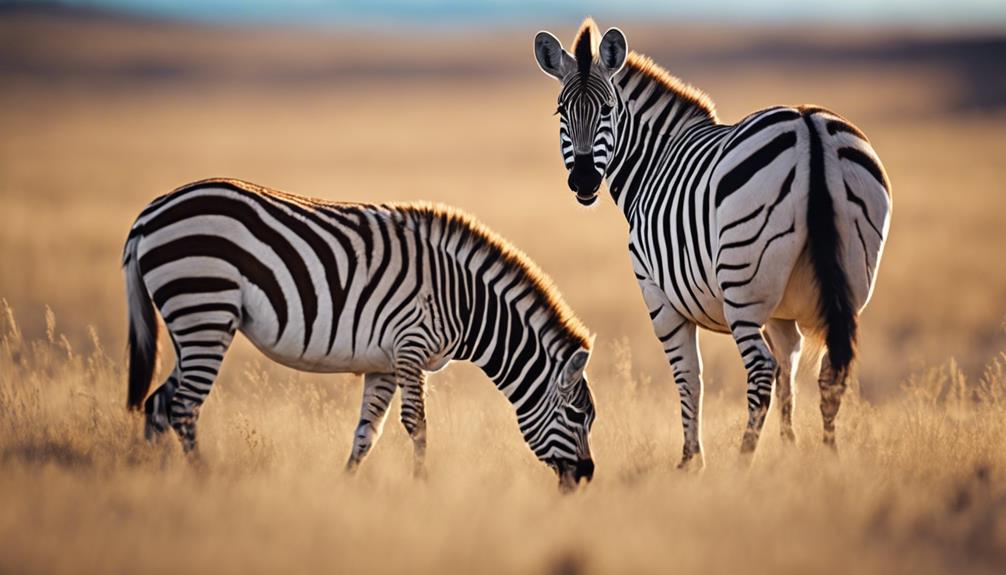
In grassland habitats, a diverse array of animals thrive among the dominant grasses, rush, and sedge. These open landscapes provide ideal conditions for a variety of creatures to flourish.
You’ll notice large herbivores like zebras and buffalos grazing on the abundant grass, while predators such as lions and cheetahs stalk their prey with the tall vegetation offering both cover and visibility. Birds like meadowlarks and hawks soar overhead, taking advantage of the vast skies and plentiful insects that inhabit the grasslands.
Some animals, like prairie dogs, utilize elaborate burrow systems to escape the heat of the day and avoid predators that roam the plains. With adaptations like keen eyesight for hunting at night, or digestive systems specialized for processing tough grasses, the animals of the grasslands have evolved unique strategies to thrive in this dynamic ecosystem.
Key Grassland Animal Adaptations
In addition, some grassland animals have developed specialized digestive systems to efficiently process the tough and fibrous grass they primarily feed on. For instance, animals like buffalo have complex stomachs with multiple chambers to break down cellulose effectively. This adaptation allows them to extract maximum nutrients from the grass they consume. Besides, animals like meerkats have adapted to live in underground burrows, providing shelter from extreme temperatures and avoiding predators. These diverse adaptations showcase the resilience and ingenuity of grassland animals in thriving in their unique habitat.
Notable Grassland Animal Species
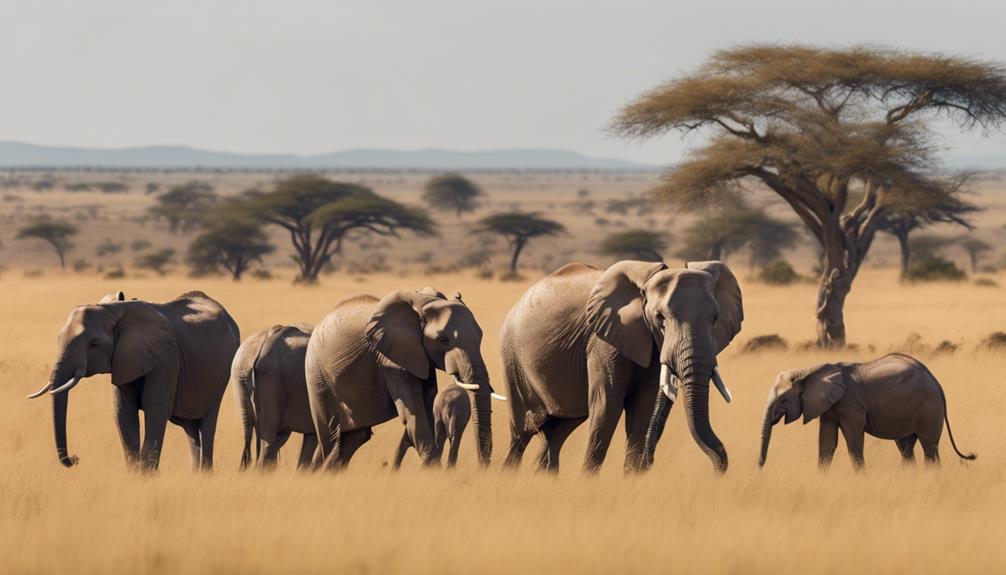
Among the notable grassland animal species, the majestic African lion stands out as a symbol of power and grace in the vast savannas. Lions live in social groups called prides, consisting of related females and their young, while males come and go.
Another iconic grassland animal is the zebra, known for its distinctive black and white stripes, which act as camouflage against predators like lions.
The wildebeest, famous for its great migration in the Serengeti, is a herbivore that plays a critical role in the grassland ecosystem by grazing on the savanna’s vegetation.
The cheetah, the fastest land animal, roams the grasslands in search of its next prey, relying on its speed and agility to catch animals like gazelles.
Lastly, the African elephant, the largest terrestrial mammal, can also be found in grassland habitats, using its trunk to forage for grasses and other vegetation.
These remarkable animals contribute to the diversity and beauty of the grassland biome.
Grassland Animal Diet Variations
Exploring the diverse dietary preferences of grassland animals reveals fascinating adaptations for survival in their dynamic ecosystem. From the bulky herbivores like bison and wildebeest that munch on grass all day to the nimble antelopes that prefer tender shoots and leaves, the grasslands host a wide array of dietary variations.
Rodents like prairie dogs and kangaroo rats are herbivores, feeding on seeds and plants, while carnivores such as cheetahs and lions feast on the herbivores that roam the open plains. Birds like ostriches are omnivores, dining on both plants and insects, showcasing their adaptability in this ever-changing environment.
Some animals, like the aardvark, have specialized diets, feeding mainly on termites and ants found in the grasslands. Each species’ unique diet plays an important role in maintaining the delicate balance of the grassland ecosystem, highlighting the intricate interdependence of its inhabitants.
Grassland Animal Hunting Techniques
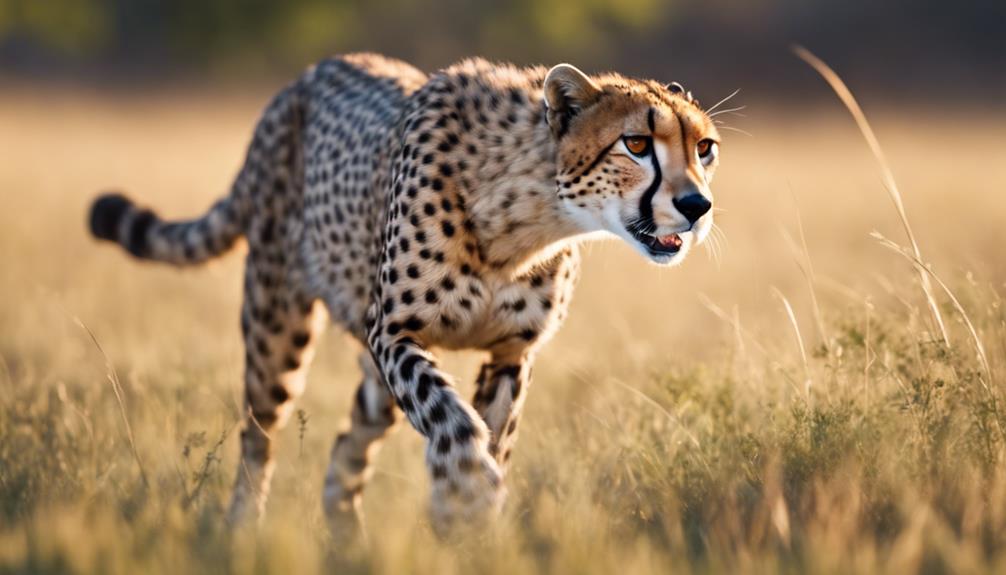
Grassland animals employ a variety of cunning hunting techniques to secure their next meal in the vast open plains. Cheetahs, the fastest land animals, rely on their incredible speed to chase down prey such as gazelles and impalas. Their keen eyesight helps them spot distant targets, while their stealth and agility aid in closing the distance swiftly.
African wild dogs, on the other hand, often hunt in packs, utilizing teamwork to surround and outmaneuver larger herbivores like bison or elk. They coordinate their movements to tire out the prey and take it down together.
Birds of prey like hawks and eagles soar high above the grasslands, using their sharp talons and beaks to snatch rodents and small mammals scurrying below. These aerial hunters possess exceptional vision and diving speeds to catch their unsuspecting victims.
Grassland predators have evolved diverse strategies to adapt to the wide-open spaces and elusive prey, showcasing the intricate balance between hunter and hunted in this dynamic ecosystem.
Grassland Animal Reproduction Strategies
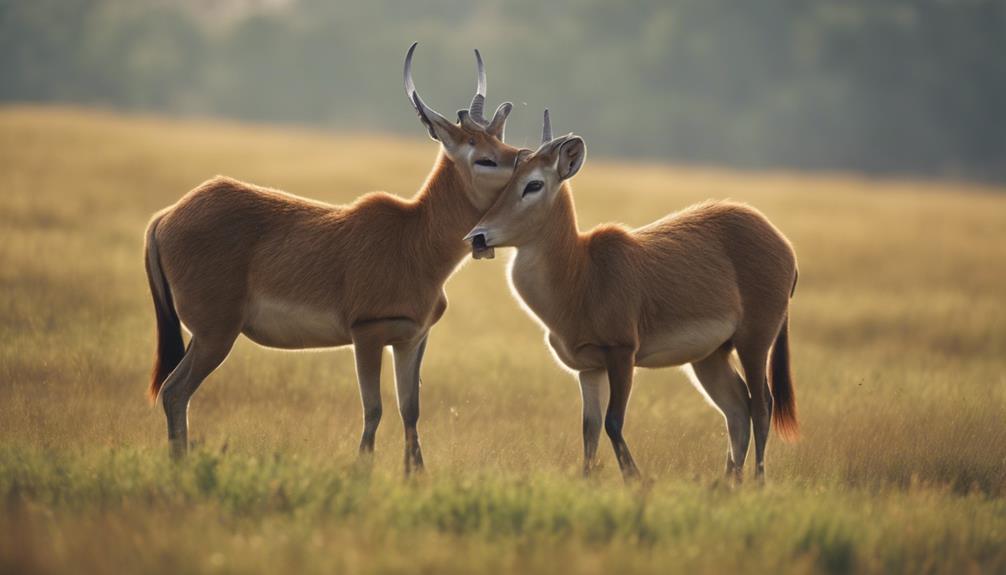
Moving on from the discussion of hunting techniques in grassland animals, a crucial aspect to explore now is their diverse strategies for reproduction.
Grassland animals have developed various reproductive adaptations to guarantee the survival of their species in this challenging environment. Many species have evolved to have high reproductive rates to compensate for the high mortality rates typical in grasslands. For example, rodents like prairie voles reproduce quickly and frequently to maintain their population numbers.
Other grassland animals, such as wildebeests and zebras, exhibit synchronized breeding patterns, taking advantage of abundant resources during specific times of the year. This strategy increases the chances of survival for their offspring by ensuring they’re born during favorable conditions.
Additionally, some grassland animals, like lions and elephants, invest heavily in parental care to protect and nurture their young, increasing their chances of survival in the grassland habitat. These diverse reproductive strategies highlight the adaptability and resilience of grassland animals in the face of environmental challenges.
Grassland Animal Camouflage Mechanisms
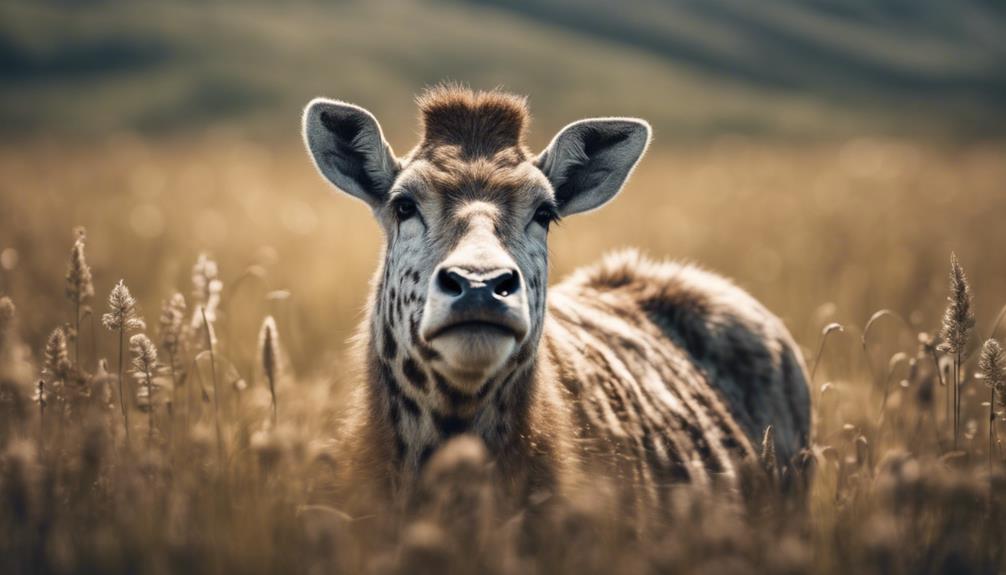
Camouflage mechanisms in grassland animals serve as important tools for evading predators and enhancing hunting success. These animals have evolved various strategies to blend into their surroundings effectively. For instance, the swift fox possesses a coat color that matches the dry grass, enabling it to hide from predators like hawks and coyotes. Similarly, the cheetah’s spotted fur helps it to stalk prey without being noticed until the last moment when it releases its lightning-fast sprint. Some grassland birds, such as the meadowlark, have intricate patterns on their feathers that provide excellent camouflage against the grass and soil, allowing them to evade aerial predators.
Other animals, like the grasshopper, use mimicry to resemble the grass or leaves they rest on, making them less visible to predators. The plains zebra’s striped coat is thought to confuse predators regarding the individual animal’s size or blend into a herd, making it harder for predators to single out a target. These camouflage mechanisms are essential for the survival of grassland animals in their open and exposed habitats.
Threats to Grassland Animal Populations

With increasing human encroachment and habitat destruction, the survival of grassland animals is facing significant challenges. As human populations expand, grasslands are being converted into agricultural lands, urban areas, and industrial zones, leading to the fragmentation and loss of vital habitats for these animals. This encroachment disrupts migration routes, reduces available food sources, and increases the risk of human-wildlife conflicts.
Moreover, overgrazing by livestock, invasive species, climate change, and wildfires also pose threats to grassland animal populations. Overgrazing can deplete grass resources, making it harder for native species to find food and shelter. Invasive species outcompete native animals for resources, disrupting the delicate balance of the ecosystem. Climate change brings about extreme weather events, altering the availability of water and food. Wildfires, whether natural or human-caused, can destroy vast areas of grasslands, leaving animals without homes and resources.
To guarantee the long-term survival of grassland animals, concerted conservation efforts and sustainable land management practices are essential in mitigating these threats.
Conservation Efforts for Grassland Animals
Collaborating with local communities, governments, and conservation organizations is important in developing sustainable land management practices that balance human needs with wildlife conservation.
Additionally, raising awareness about the importance of grassland ecosystems and the species within them can inspire individuals to take action to protect these valuable habitats. Supporting research initiatives to better understand the ecology and behavior of grassland animals is also essential for informed conservation decision-making.
Grassland Animal Interactions With Humans
On one hand, human activities like farming can provide food sources for certain species, while domesticated animals contribute to the grassland ecosystem through grazing. However, human development has also led to habitat destruction, fragmentation, and pollution, threatening the survival of many grassland animal species.
Moreover, human-wildlife conflicts arise when animals cause damage to crops or livestock, prompting interventions that can disrupt natural behaviors and populations. Conservation efforts and sustainable practices are essential to mitigate these conflicts and protect the biodiversity of grassland animals. By fostering a balanced relationship with grassland fauna, humans can secure the preservation of these critical ecosystems for future generations.
Grassland Animal Role in Ecosystem
Grazing animals like zebras, bison, and antelopes help control the growth of grass and vegetation, preventing overgrowth and promoting plant diversity. Burrowing animals such as prairie dogs aerate the soil, allowing for better water infiltration and nutrient cycling. Predators like lions and cheetahs regulate prey populations, preventing any one species from dominating the ecosystem. Additionally, scavengers like vultures and hyenas help clean up the landscape by consuming carcasses, preventing the spread of disease.
Each species contributes uniquely to the functioning of the grassland ecosystem, highlighting the intricate web of interdependence that exists within this habitat. Efforts to conserve grassland animals are important for maintaining the delicate balance and biodiversity of these important landscapes.

Erzsebet Frey (Eli Frey) is an ecologist and online entrepreneur with a Master of Science in Ecology from the University of Belgrade. Originally from Serbia, she has lived in Sri Lanka since 2017. Eli has worked internationally in countries like Oman, Brazil, Germany, and Sri Lanka. In 2018, she expanded into SEO and blogging, completing courses from UC Davis and Edinburgh. Eli has founded multiple websites focused on biology, ecology, environmental science, sustainable and simple living, and outdoor activities. She enjoys creating nature and simple living videos on YouTube and participates in speleology, diving, and hiking.
🌿 Explore the Wild Side!
Discover eBooks, guides, templates and stylish wildlife-themed T-shirts, notebooks, scrunchies, bandanas, and tote bags. Perfect for nature lovers and wildlife enthusiasts!
Visit My Shop →
